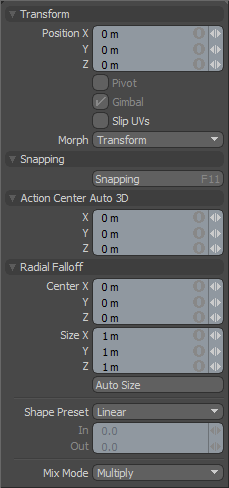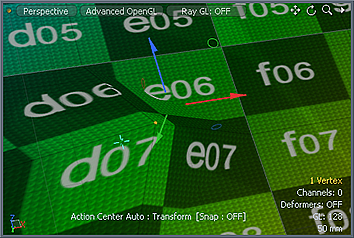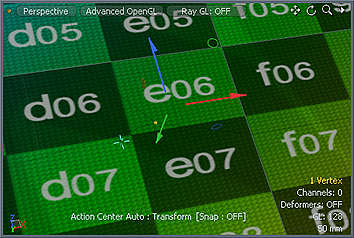
 Found in the 'Deform' subtab of the modeling toolbox, the Soft Move is a tool preset that consists of the Transform tool with Radial Falloff. This lets users select vertices, edges or polygons and move them, attenuating the amount of movement to neighboring items based on the size of the radial falloff producing a soft, organic deformation. Use the right-mouse button to define the radial falloff interactively.
Found in the 'Deform' subtab of the modeling toolbox, the Soft Move is a tool preset that consists of the Transform tool with Radial Falloff. This lets users select vertices, edges or polygons and move them, attenuating the amount of movement to neighboring items based on the size of the radial falloff producing a soft, organic deformation. Use the right-mouse button to define the radial falloff interactively.
Transform--
Position: Users may use the X,Y and Z input fields to apply specific offset distance values (calculated from position the object was in when the tool was activated). When adjusting an object interactively in the viewport, the 'Position' input fields will display the current offset distance applied, providing useful user feedback.
Pivot: Disabled for the 'Soft Move' tool.
Gimbal: Disabled for the 'Soft Move' tool.
Child Compensate: (Only in Items Mode) The 'Child Compensate' toggle when disabled will pass along the transform value to any child items of the current selection, when enabled, the child items will ignore any transform values.
Slip UVs: (Only in Component Modes) UV values are generally fixed to specific vertices, subsequently further edits to the geometry may warp, deform or otherwise distort the UV values in undesirable ways requiring users to adjust the map or redo it altogether. To avoid this undesirable result, users can enable the 'Slip UVs' function so as to not disturb any existing UV mapping applied to the geometry.
 'Slip UVs' function disabled, note texture warping. |  'Slip UVs' function enabled, texture remains even. |
Morph: (Only in Component Modes) The Morph option determines how MODO treats stored Morph information when applying transforms to geometry (Move, Rotate, Scale, etc.). In previous versions of MODO, in order to transform a Morph along with its base, it needed to be selected in the Vertex Map list. If it wasn't, relative Morph map data when recalled would produce distorted, undesirable results. If users were unaware of the requirements, it was easy to accidentally mess up a model. To remedy this problem, there are now three options controlling how the Morph Map vertex data is dealt with when applying any transforms--
None- Unselected Morph data is not affected, though selected (visible) Morphs can still be transformed independent of their source.
Transform- With this option selected, Morph data is transformed along with base mesh.
Keep Positions- With this option Selected, Morph data is converted into a Absolute Morph Map and all vertices retain their pre-transformed positions.
Snapping--
Please reference the 'Snapping' Section of the documentation.
Radial Falloff--
Center X/Y/Z: Defines the Center of influence, where the strength of the Falloff will be greatest (100%). The strength of the falloff will attenuate toward the outer bounds of the Spherical volume, the area outside the volume receives no tool influence.
Size X/Y/Z: Defines the radius of a perfect circle from the 'Center' and determines the outer area of the Falloff where there is no affect.
Auto Size: Users can select this option to automatically size the Falloff's 'Center' and 'Size' values to match the bounding box of the current selection.
Shape Preset: The strength of the Falloff's influence can be controlled along the extent using a 'Shape Preset'-
Linear- Attenuation of Falloff occurs evenly across its range.
Ease-In- Strength of Falloff is greater toward the 'Start' position.
Ease-Out- Strength of Falloff is greater toward the 'End' position.
Smooth- Strength of Falloff is greater toward the center of the Falloff.
Custom- Users can use the 'In'/'Out' options to fine tune strength of Falloff.
In/Out: The 'In' value determines the strength of the Falloff nearer to the 'Start' position, where the 'Out' value determines the strength on nearer the 'End' side of the Falloff.
Mix Mode: In instances where there are multiple falloffs applied to a transform (using the 'Add' option of the Falloff menu), the mix mode defines how each Falloff interacts with the other.


